
The Solar-Terrestrial Centre of Excellence (STCE) is a collaborative network of the Belgian Institute for Space Aeronomy, the Royal Observatory of Belgium and the Royal Meteorological Institute of Belgium.
 |
Published by the STCE - this issue : 29 Aug 2013. The Solar-Terrestrial Centre of Excellence (STCE) is a collaborative network of the Belgian Institute for Space Aeronomy, the Royal Observatory of Belgium and the Royal Meteorological Institute of Belgium. |
| Archive of the newsletters | Subscribe to this newsletter by mail |
Solar filaments are clouds of ionized gas above the solar surface squeezed between magnetic regions of opposite polarity. Being cooler and denser than the plasma underneath and their surroundings, they appear as dark lines when seen on the solar disk using special filters. Space weather forecasters keep an eye on these filaments. Indeed, as the magnetic regions suspending the filament may become unstable, the filament can erupt and throw a cloud of charged particles towards the Earth where it can cause geomagnetic disturbances. These eruptions are more likely to occur as the filament grows longer, typically around 200,000 km. Such long filaments usually develop outside sunspot groups.
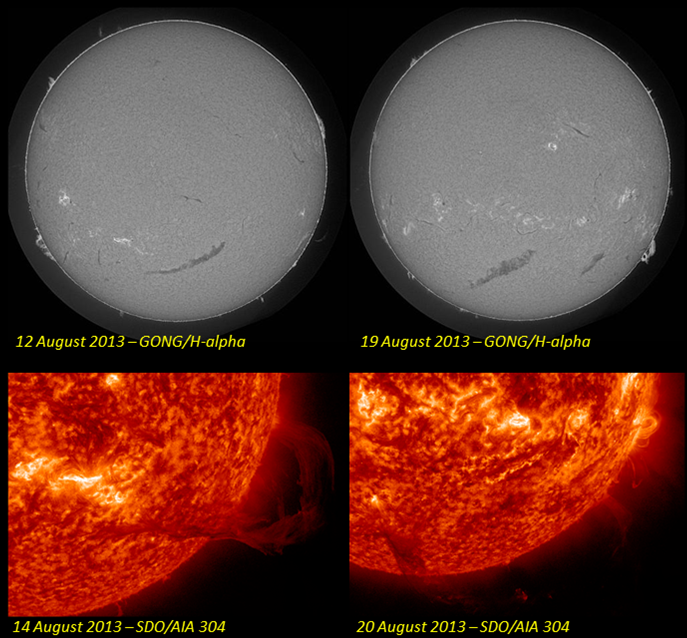

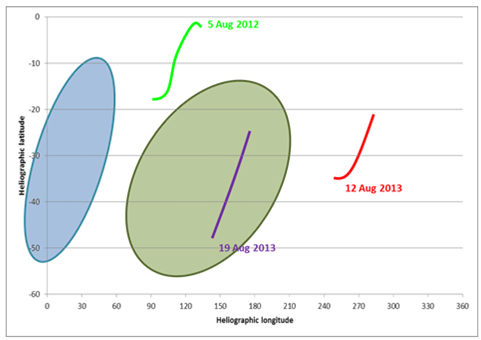
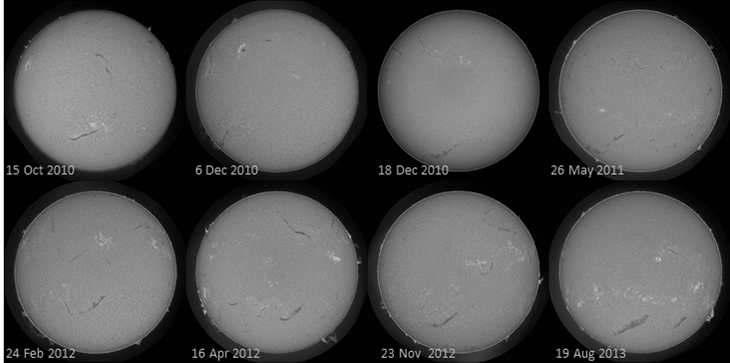
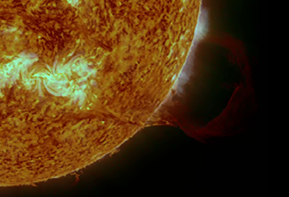
Solar activity was low during the week with only C-class flares. This weeks record was set by NOAA Active Regions, AR 1818 with a total of 5 C-flares. NOAA AR 1820 and 1828 share the second place with each 3 C-flares. NOAA AR 1820 subscribed for the strongest flare of the week: a C4.1 on August 22. From August 24, the peaks in the X-ray radiation measured by GOES could not reach the C-level anymore as can be seen in the red curve below.
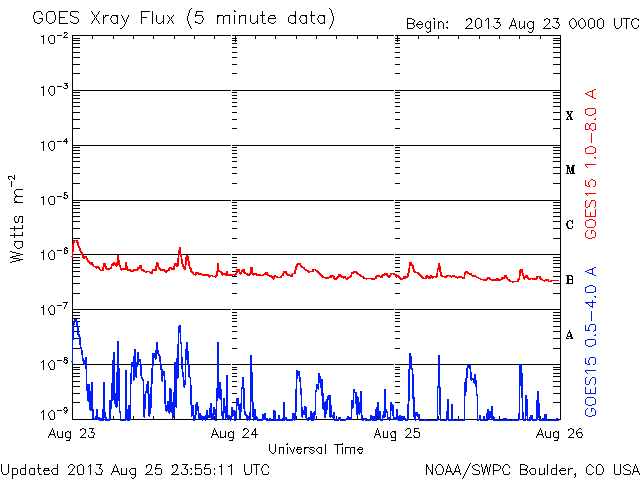
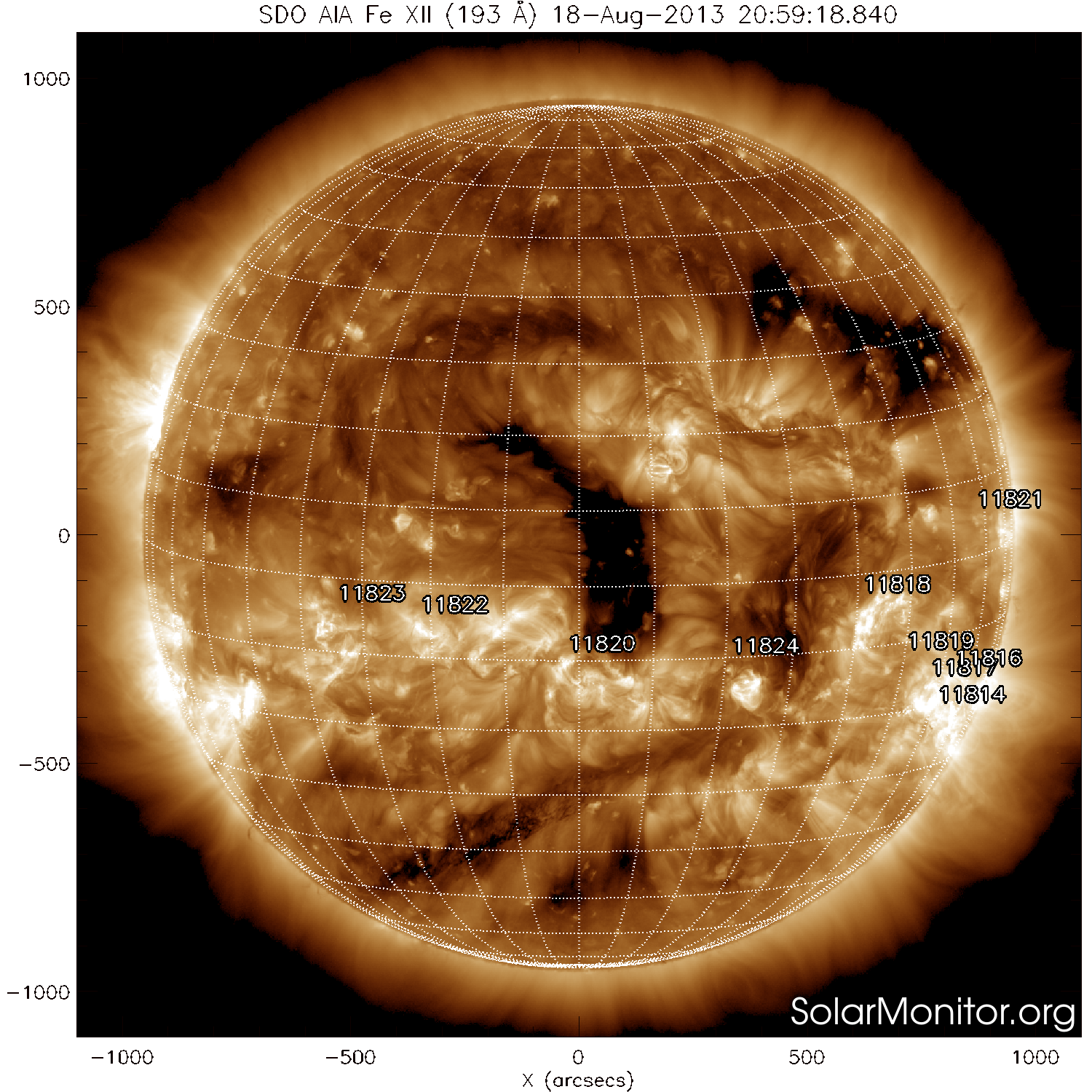
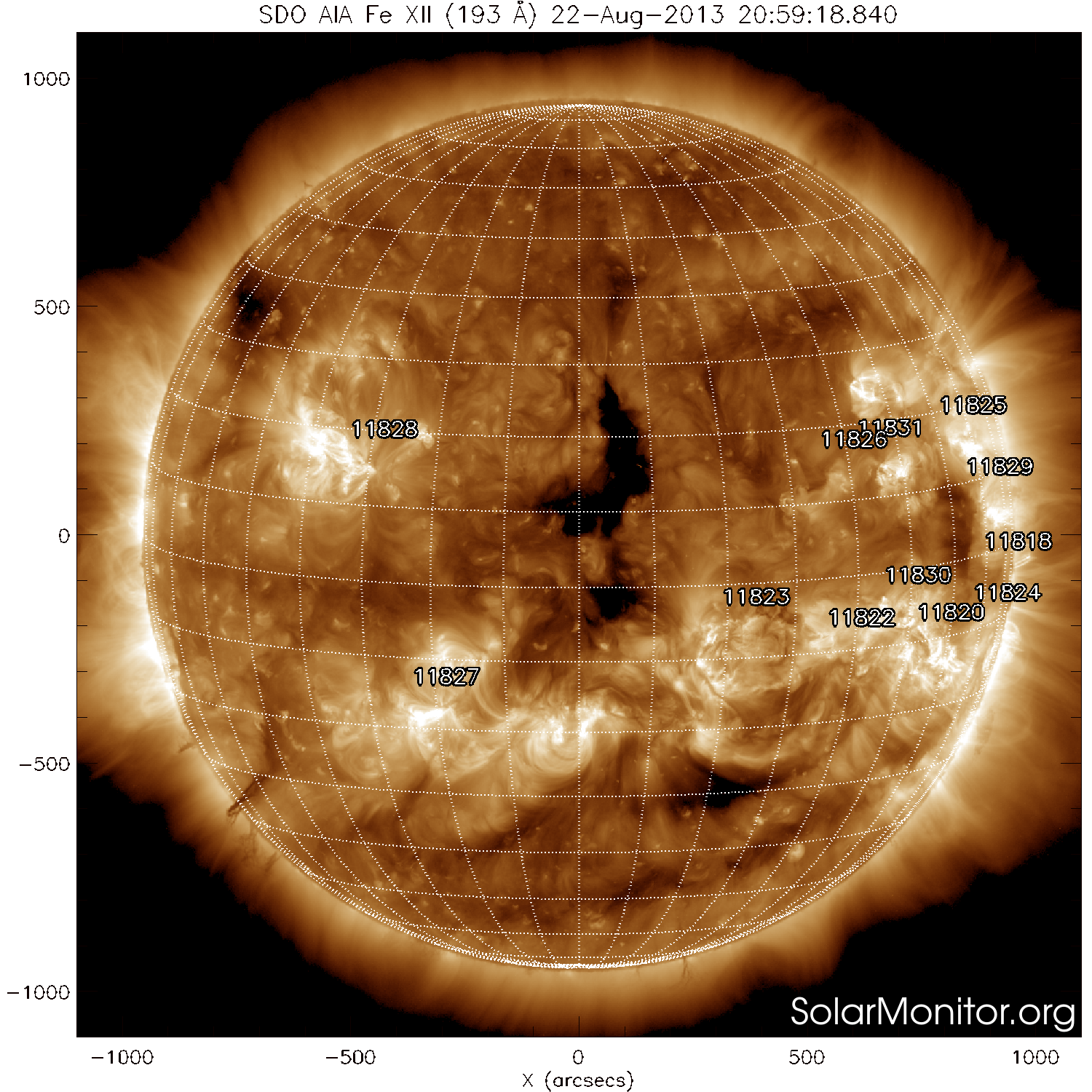
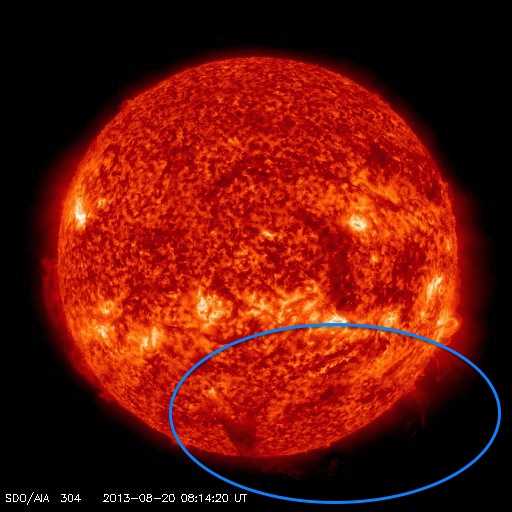
On Aug 19, the solar wind speed was still decreasing after a peak on Aug 16 due to a coronal hole, CH. On Aug 20, the solar wind had slowed down to a value slightly below 400 km/s. From that moment, it increased again to almost 600 km/s. This increase was caused by the recurrent equatorial CH mentioned above. On 21 and 22 August the local K-index at Dourbes reached the value of 4. This disturbance was due to combined effects of the fast speed stream from the recurrent equatorial CH and possibly a glancing blow of the CME that left the Sun on Aug 17.
Geomagnetic conditions were quiet to unsettled for the rest of the week.
Solar (flaring) activity evolved from low to very low during the week.
In order to view the activity of this week in more detail, we suggest to go to the following website from which all the daily (normal and difference) movies can be accessed: http://proba2.oma.be/ssa. This page also lists the recorded flaring events.
A weekly overview movie can be found here: http://proba2.oma.be/swap/data/mpg/movies/WeeklyReportMovies/WR178_Aug19toAug25_2013/2013_08_19_00_01_53_2013_08_25_20_16_03_SWAP_174-hq.mp4 (SWAP174; HelioViewer.org).
Details about some of this week’s events can be found further below.
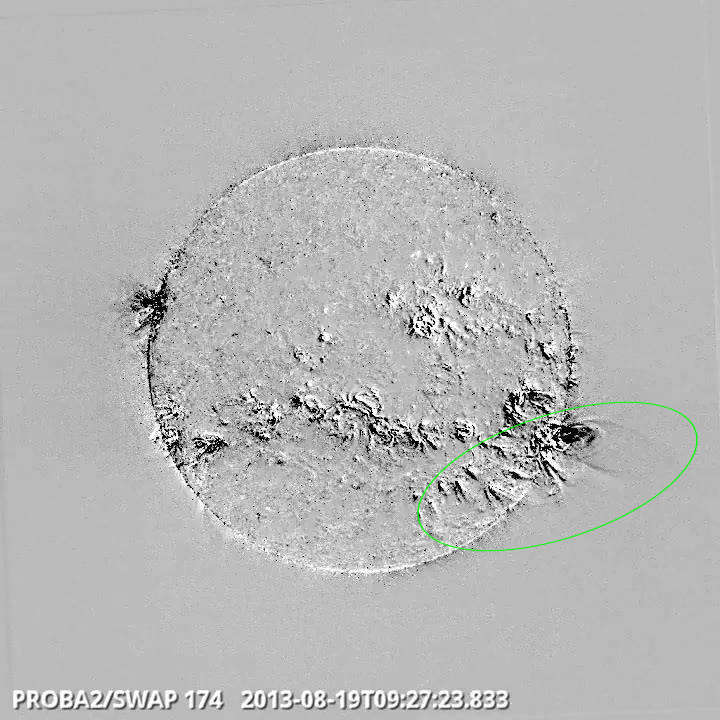
C2.2 Flare eruption in South West Quadrant @ 09:27 - SWAP difference image
Find a movie of the event here: http://proba2.oma.be/swap/data/mpg/movies/WeeklyReportMovies/WR178_Aug19toAug25_2013/Events/20130819_Eruption_SouthWestQuad_0927_swap_diff.mp4 (SWAP difference movie)
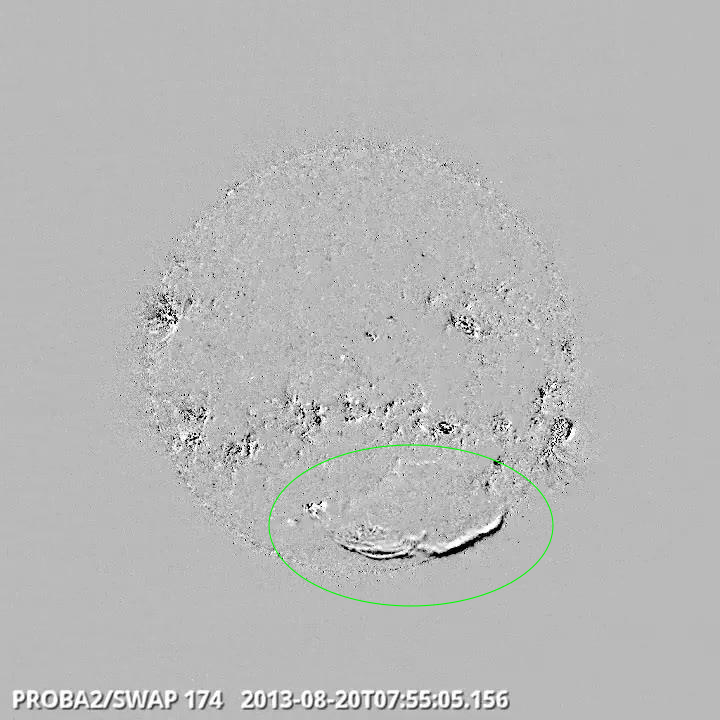
Prominence Eruption in South West Quadrant @ 07:55 - SWAP difference image
Find a movie of the event here: http://proba2.oma.be/swap/data/mpg/movies/WeeklyReportMovies/WR178_Aug19toAug25_2013/Events/20130820_BigPromEruption_SouthWestQuad_0755_swap_diff.mp4 (SWAP difference movie)
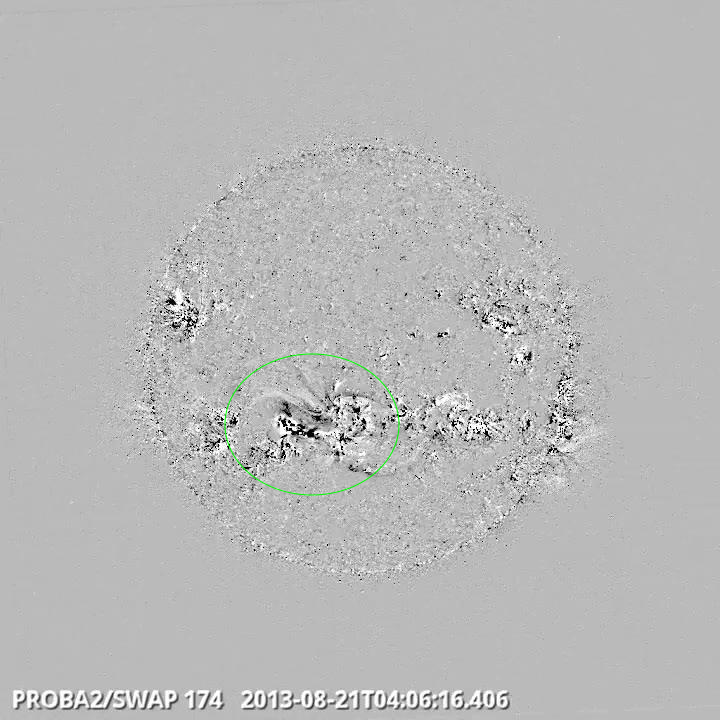
C1.3 Flare Eruption in South East Quadrant @ 04:06 - SWAP difference image
Find a movie of the event here: http://proba2.oma.be/swap/data/mpg/movies/WeeklyReportMovies/WR178_Aug19toAug25_2013/Events/20130821_Eruption_SouthEastQuad_0406_swap_diff.mp4 (SWAP difference movie)
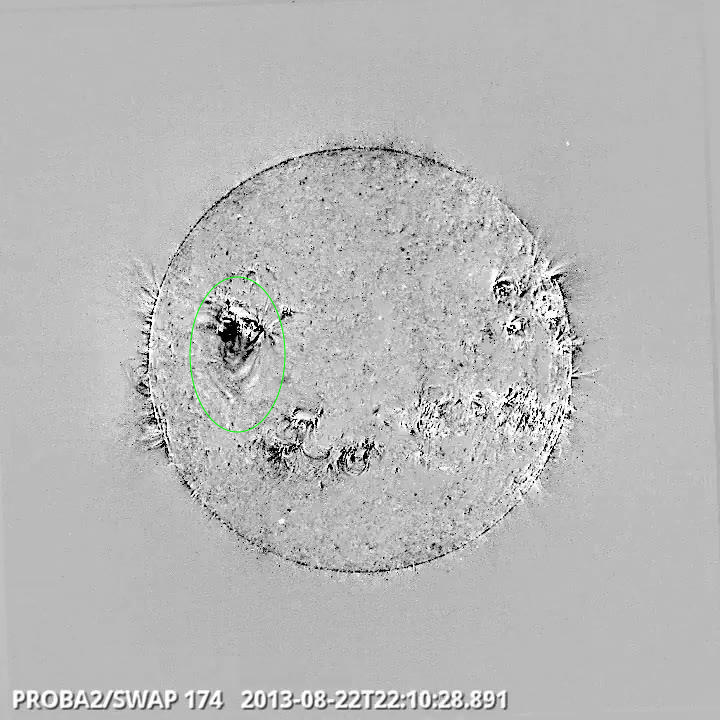
C1.9 Flare Eruption in North East Quadrant @ 22:10 - SWAP difference image
Find a movie of the event here: http://proba2.oma.be/swap/data/mpg/movies/WeeklyReportMovies/WR178_Aug19toAug25_2013/Events/20130822_C19FlareEruption_NorthEastQuad_2210_swap_diff.mp4 (SWAP difference movie)
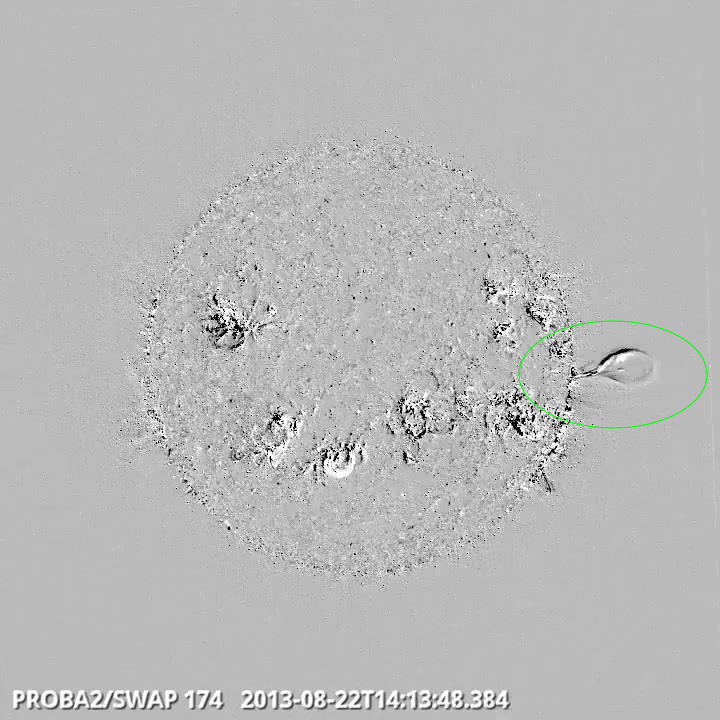
Eruption on the West Limb @ 14:13 - SWAP difference image
Find a movie of the event here: http://proba2.oma.be/swap/data/mpg/movies/WeeklyReportMovies/WR178_Aug19toAug25_2013/Events/20130822_Eruption_WestLimb_1413_swap_diff.mp4 (SWAP difference movie)
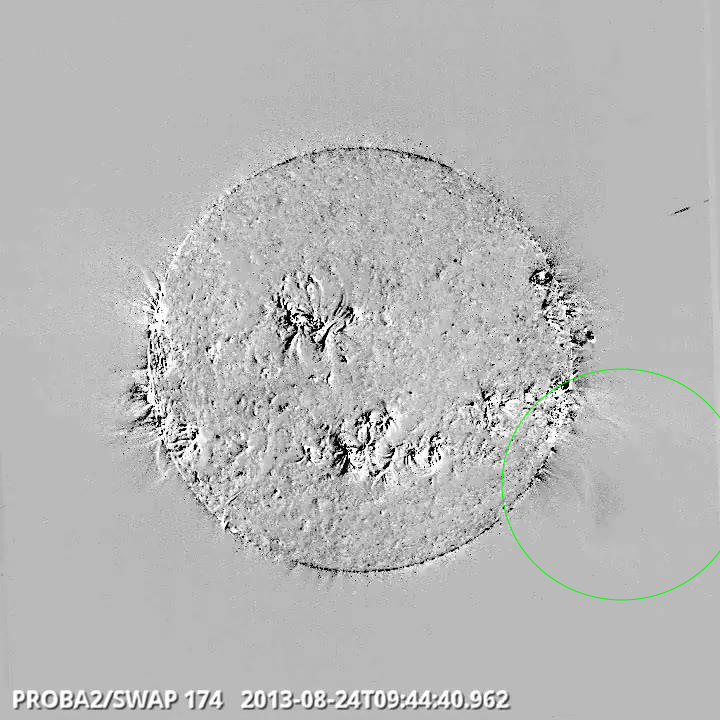
Eruption on the South West Limb @ 09:44 - SWAP difference image
Find a movie of the event here: http://proba2.oma.be/swap/data/mpg/movies/WeeklyReportMovies/WR178_Aug19toAug25_2013/Events/20130824_Eruption_SouthWestLimb_0944_swap_diff.mp4 (SWAP difference movie)
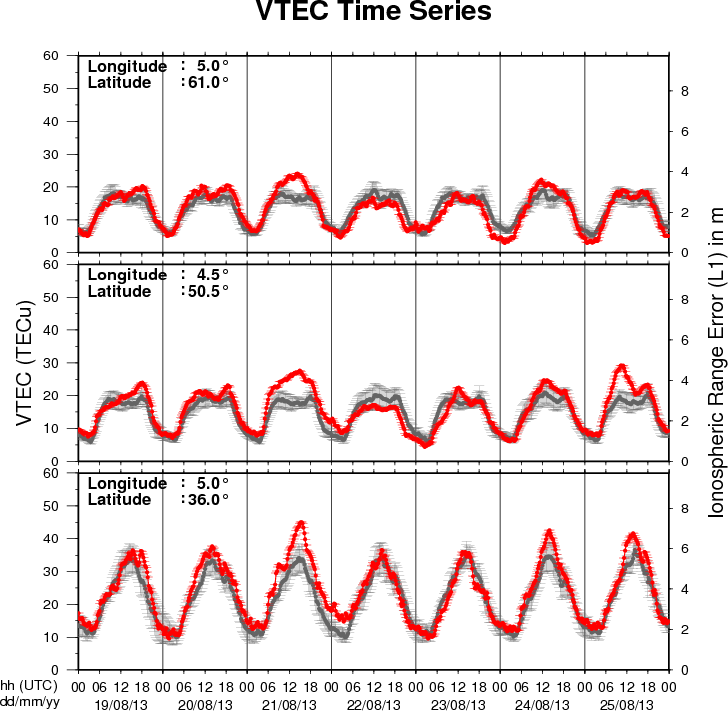
The figure shows the time evolution of the Vertical Total Electron Content (VTEC) (in red) during the last week at three locations:
a) in the northern part of Europe(N61°, 5°E)
b) above Brussels(N50.5°, 4.5°E)
c) in the southern part of Europe(N36°, 5°E)
This figure also shows (in grey) the normal ionospheric behaviour expected based on the median VTEC from the 15 previous days.
The VTEC is expressed in TECu (with TECu=10^16 electrons per square meter) and is directly related to the signal propagation delay due to the ionosphere (in figure: delay on GPS L1 frequency).
The Sun's radiation ionizes the Earth's upper atmosphere, the ionosphere, located from about 60km to 1000km above the Earth's surface.The ionization process in the ionosphere produces ions and free electrons. These electrons perturb the propagation of the GNSS (Global Navigation Satellite System) signals by inducing a so-called ionospheric delay.
See http://stce.be/newsletter/GNSS_final.pdf for some more explanations ; for detailed information, see http://gnss.be/ionosphere_tutorial.php
Start : 2013-09-04 - End : 2013-09-06
The purpose of the meeting is to provide a forum for the italian
scientists in the field (some of which are abroad) to consolidate
on-going collaborations and establish new ones, for example in
future projects such as Solar Orbiter and EST, where several of us
are involved.
The meeting is obviously open to scientists from all the
countries!
Website:
http://www.oact.inaf.it/weboac/SoHe2013/
Start : 2013-09-09 - End : 2013-09-14
We gain information about the universe through analysis of the
spectra from celestial objects. However, while the intensity
spectrum represents a scalar quantity but electromagnetic radiation
occurs in the form of transverse waves, the polarized spectrum
provides us with a 4-vector, the Stokes vector. The increased
amount of information space opens new windows to the universe, in
particular for the exploration of magnetic fields. It is well
recognized that the magnetic field is a primary agent responsible
for structuring and the source of all variability on intermediate
time scales, which manifests itself in all forms of solar and
stellar activity.
It is therefore not surprising that every year there are many
scientific meetings organized with the objective of studying the
role of magnetic fields in cosmic objects. What is largely missing
in these meetings is however an in-depth investigation of the
fundamental aspects of how magnetic fields can be determined by the
means of spectro-polarimetry, our main gateway to cosmic magnetism.
The primary aim of our series of Workshops is to address these
fundamental aspects, with less emphasis on the morphological and
physical properties of cosmic magnetic fields.
Website: http://spw7.ynao.ac.cn/
Start : 2013-09-16 - End : 2013-09-20
The meeting will cover a broad range of aspects of solar
physics, space science and solar-terrestrial relations. We aim to
include every side of solar and space research, including
observations, theory, and numerical modelling. The main idea behind
the meeting is to treat the entire solar-terrestrial domain as one
system, rather than each region independently.
The topics to be covered are:
* advanced solar observations
* waves and flows in the Solar atmosphere
* structure and dynamics of solar magnetic fields
* connecting analytical theory and modern numerical simulations
to observations
* new physics in numerical modelling
* linking solar interior with heliosphere
* particle acceleration in the Sun and heliosphere
* non-linear phenomena in space plasmas
* physics of magnetosphere and ionosphere
Website:
http://swat.group.shef.ac.uk/Conferences/Ukraine_UK_2013/index.html
Start : 2013-09-16 - End : 2013-09-19
This summer school targets to introduce a generation of young
researchers (advanced master students, PhDs, and junior
postdoctoral researchers) to the diverse aspects of space weather
related research.
It will introduce theoretical approaches to space weather and
its drivers, present modern solar data analysis tools, and cover
state-of-the-art solar and space science simulations. Participants
will learn about forecasting aspects and their quality control for
space weather events, but also experience hands-on training in
scientific proposal writing and receive do-and-don't tips for
scientific presentations.
The scientific program is enriched by a public evening lecture
on the solar influence on our climate, and the lecturers are
invariably expert scientists with international standing.
The school is open to a maximum of 40 participants, and can
benefit from its embedding within two international research
network activities: an Interuniversity Attraction Pole P7/08 CHARM
connecting heliospheric to astrophysical communities with 7 partner
institutes, and a European FP7 Project eHeroes with 15 different
partner institutes. Participation from outside both network
activities is strongly encouraged. Within Belgium, the school links
up expertise from universities (KU Leuven, ULB, Gent University) to
federal research institutes (the Solar-Terrestrial Centre of
Excellence, the Royal Observatory of Belgium and the Belgian
Institute for Space Aeronomy).
Website:
http://wis.kuleuven.be/CHARM/events/school/SSTW2013/
Start : 2013-10-07 - End : 2013-10-11
The aim of the workshop is to review the "state of the art"
theories about generation and propagation of Solar radio burst and
discuss the observational constrains and results that have been
provided in this area by the WIND & STEREO missions during the
last 20 years. Furthermore the STEREO & WIND observations will
be put in the context of other missions such as RHESSI and ground
based observatories. Finally, the preparation for the future
explorations foreseen with Solar Orbiter and Solar Probe Plus will
be discussed.
Website:
http://type3stereo.sciencesconf.org/
Start : 2013-10-24 - End : 2013-10-26
Initiated by Profs. Fang and Choudhury, the first Asian-Pacific
Solar Physics Meeting (APSPM) was held in Bangalore two years ago.
During the meeting, a consensus was achieved that it might be a
good idea to have the APSPM every three years. Somehow the second
APSPM was proposed to be held by mainland China in 2013. APSPM is
aimed to exchange the recent research results in solar physics in
the emerging asian-pacific region.
Asian-pacific regions are getting more and more active in solar
physics, as signified by the construction of big facilities,
including the Hinode satellite (Japan), SOXS (India), Chinese Solar
Radio Heliogragh, and Optical & Near-Infrared Solar Eruption
Tracer (ONSET). Therefore, colleagues have agreed to hold regional
solar physics meetings regularly. The first Asian-Pacific Solar
Physics Meeting (APSPM) was held in Bangalore during March 22-24
2011. During the meeting, a consensus was achieved that it might be
a good idea to have the APSPM every three years. Somehow the second
APSPM was proposed to be held by mainland China in 2013. APSPM is
aimed to exchange the recent research results in solar physics in
the emerging asian-pacific region.
Website:
http://sdac.nju.edu.cn/~solar/
Start : 2013-10-27 - End : 2013-10-31
Magnetic helicity has been intensively studied from
observational, theoretical, and many other aspects of solar
physics. For this meeting we would like to invite solar physicists
who are interested in the observational and theoretical studies of
the helicity, to encourage thorough discussions on the relevant hot
issues. The 1st Helicity Thinkshop was held successfully in 2009,
and now the 2nd one will be held on October 27-31, 2013 in Beijing,
China.
Website:
http://sun.bao.ac.cn/meetings/HT2013/
Start : 2013-10-28 - End : 2013-11-02
The Worshop and School on Radio Sun in Beijing and Inner
Mongolia during Oct.28 - Nov. 2, 2013 is the first international
academic seminar supported by the International Research Staff
Exchange Scheme of the Seventh Fromework Programme of the European
Union (FP7-IRSES-295272-RADIOSUN).
The primary aim of this programme is to establish close research
interaction and collaboration between the key research groups
involved in CSRH, SSRT, and ALMA projects and in development of
relevant theory and data analysis tools, through the systematic
research staff and knowledge exchange, joint research efforts
exploiting existing data and facilities, and preparing the future
world-class partnership in exploitation of the upcoming
facilities.
The Workshop and School welcome all solar physicsts and students
who are interested in solar radio astronomy to participate. We will
discuss and exchange the scientific frontier problems, including
the new-generation radio instruments (CSRH, Siberian
multi-frequency radioheliograph, LOFAR, ALMA, and other new
instruments), recent achievements and their scientific goals;
methods and techniques of data processing (for example, software,
radio image reconstructions, and method for studying various types
of solar radio fine structures); and the objectives of new
observational data and new mathematical methods.
Website:
http://beijingradiosun.csp.escience.cn/
Start : 2013-11-11 - End : 2013-11-22
Magnetic fields play an important role in many astrophysical
processes. But magnetic are difficult to detect and to model or
understand, since the fundamental equations describing the behavior
of magnetized plasmas are highly non-linear. Hence, magnetic fields
are often an inconvenient subject which is overlooked or simply
neglected. Such difficulty burdens the research on magnetic fields,
which has evolved to become a very technical subject, with many
small disconnected communities studying specific aspects and
details.
The school tries to amend the situation by providing a unifying
view of the subject. The students would have a chance to understand
the behavior of magnetic fields in all astrophysical contexts, from
cosmology to the Sun. From star-bursting regions to AGNs in
galaxies. The school will present a balanced yet complete review of
our knowledge. Extensions into the unknown are also important to
indicate present and future lines of research.
The Winter School will bring together in a relaxed working
atmosphere a number of the leading scientists in this field, PhD
students and recent postdocs. The conditions for a successful
interaction will be granted, including two special sessions for
those students that want to present their own work.
Website:
http://www.iac.es/winterschool/2013/
Start : 2013-11-12 - End : 2013-11-15
Since its launch in Sep-2006, more than 600 refereed papers have
been published based on Hinode observations, presenting many new
and important findings to the scientific community. However, due to
the unexpectedly low levels of solar activity, until now the focus
has mainly been on the more quiescent aspects of the solar cycle.
With the solar maximum expected this year, through cooperative
observations with SDO, IRIS, and ground based observatories, Hinode
observations should lead to our understanding of active Sun
phenomena, such as solar flares and CMEs, to be greatly improved.
Making Hinode-7 an excellent opportunity to discuss solar activity
in the current solar cycle and the related science through the use
Hinode data, as well as other solar/space weather data. It will
also be interesting to use this meeting to broaden our focus to
include the solar-stellar connection as a means to deepen our
understanding of solar activity.
Momentum is also gaining for Solar-C, which is being developed
as an international collaboration between Japan, US and Europe. To
further discuss this mission, the Solar-C science meeting will be
held on 11-Nov.
Website:
http://www.kwasan.kyoto-u.ac.jp/hinode-7/
Start : 2013-11-18 - End : 2013-11-22
This International CAWSES-II Symposium hosted by SCOSTEP
(Scientific Committee on Solar-Terrestrial Physics) will provide an
excellent opportunity to discuss the scientific accomplishments of
CAWSES-II and look forward to SCOSTEP's future programs at a moment
toward the end of its five-year period. The symposium will cover
the six major themes of CAWSES-II tasks: 1) What are the solar
influences on the Earth's climate?, 2) How will geospace respond to
an altered climate?, 3) How does short-term solar variability
affect the geospace environment?, 4) What is the geospace response
to variable inputs from the lower atmosphere?, 5) Capacity
Building, 6) Informatics and eScience. The main functions of
CAWSES-II are to help coordinate international activities in
observations, modeling, and applications crucial to achieving this
understanding, to involve scientists in both developed and
developing countries, and to provide educational opportunities for
students of all levels. The symposium offers keynotes/lectures that
will be interesting for all participants every morning and more
specific sessions of presentations in the afternoon. We welcome all
those who are involved and/or interested in CAWSES-II to Nagoya in
the autumn when we will have the pleasure of being surrounded by
beautiful colorful leaves of this season.
Website:
http://www.cawses.org/CAWSES/leaflet_CAWSES-II_120229.pdf
Start : 2013-11-18 - End : 2013-11-22
The 10th Edition of the European Space Weather
Week will take place on 18-22nd
November 2013 in Belgium. The venue will be confirmed early next
year, but mark your calendars now for the 10th Anniversary of this
growing European event.
The ESWW will again adopt the central aim of bringing together
the diverse groups in Europe working on different aspects of Space
Weather
. This includes but isn't
limited to the scientific community, the engineering community,
applications developers, service providers and service end users.
The meeting organisation will again be coordinated by the Belgian
Solar-Terrestrial Centre of Excellence (STCE), ESA
and the Space Weather
Working Team. The local
organisation will be done by the STCE.
Website:
http://www.stce.be/esww10/
Start : 2014-06-23 - End : 2014-06-27
The meeting in honour of Prof. Zdenek Svestka will cover issues
of the physics of solar and stellar flares.
Website:
http://solarflares2014.cz/
Start : 2014-08-02 - End : 2014-08-10
The 40th COSPAR Scientific Assembly will be held in Moscow,
Russia from 2 - 10 August 2014. This Assembly is open to all bona
fide scientists.
Website:
http://www.cospar-assembly.org/
Start : 2014-09-08 - End : 2014-09-12
The European Solar Physics Meetings aim to highlight all aspects
of modern solar physics, including observation and theory that span
from the interior of the Sun out into the wider heliosphere. These
meetings provide a broad, yet stimulating, environment for European
and international scientists to share their research in solar
physics.
The meeting will mostly comprise of contributed talks and poster
presentations, with several invited review talks (typically one per
session). Posters will be on display for the whole meeting in close
proximity to the lecture theatre. Refreshments will be served in
the poster viewing area during two dedicated coffee/poster breaks
on each full day.
Website: http://www.espm14.ie/
http://www.spaceweather.eu/en/repository/show?id=476
http://www.spaceweather.eu/en/repository/show?id=477
In this tutorial I show step by step how to calculate the single event upset rate for a planned mission with the SPENVIS SEE tool.
http://www.spaceweather.eu/en/repository/show?id=478
In this tutorial I give an overview of the spacecraft charging analysis tools, charging environment models and data sets that are available inside SPENVIS.
http://www.spaceweather.eu/en/repository/show?id=479
In this turial I give an overview of the radiation environment models and effect tools available in SPENVIS.
http://www.spaceweather.eu/en/repository/show?id=480